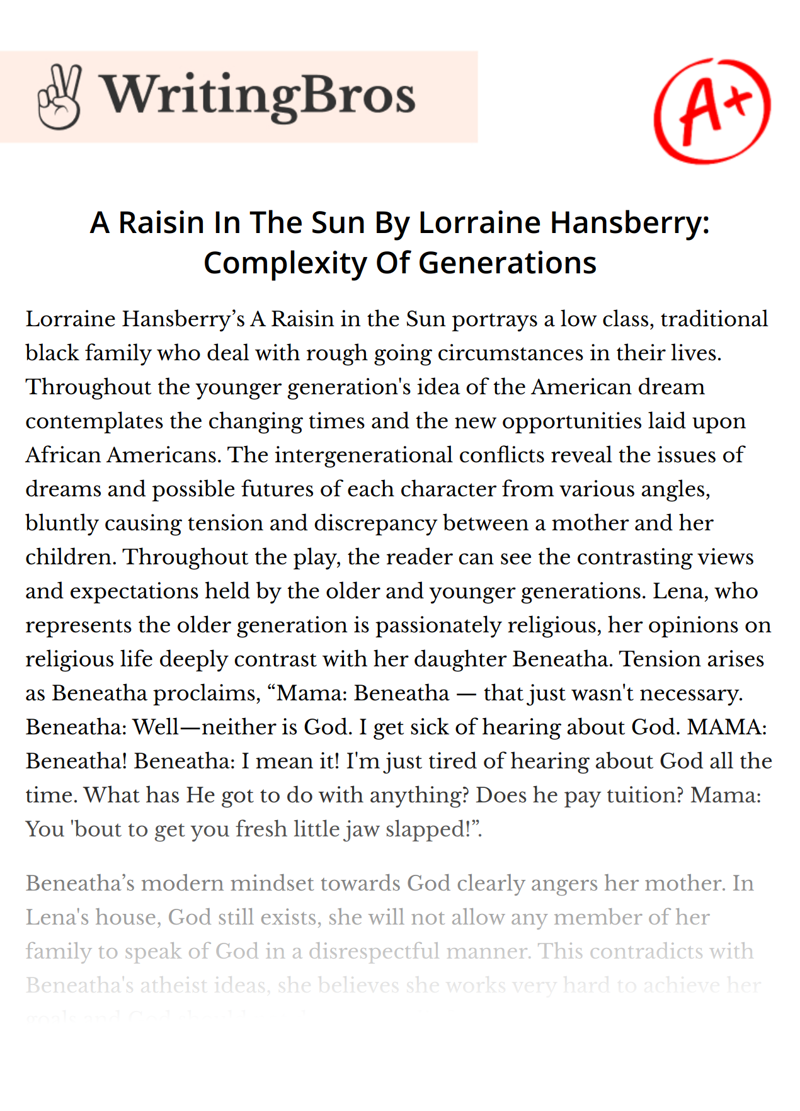A Raisin In The Sun By Lorraine Hansberry: Complexity Of Generations

Lorraine Hansberry’s A Raisin in the Sun portrays a low class, traditional black family who deal with rough going circumstances in their lives. Throughout the younger generation's idea of the American dream contemplates the changing times and the new opportunities laid upon African Americans. The intergenerational conflicts reveal the issues of dreams and possible futures of each character from various angles, bluntly causing tension and discrepancy between a mother and her children. Throughout the play, the reader can see the contrasting views and expectations held by the older and younger generations. Lena, who represents the older generation is passionately religious, her opinions on religious life deeply contrast with her daughter Beneatha. Tension arises as Beneatha proclaims, “Mama: Beneatha — that just wasn't necessary. Beneatha: Well—neither is God. I get sick of hearing about God. MAMA: Beneatha! Beneatha: I mean it! I'm just tired of hearing about God all the time. What has He got to do with anything? Does he pay tuition? Mama: You 'bout to get you fresh little jaw slapped!”.
Beneatha’s modern mindset towards God clearly angers her mother. In Lena's house, God still exists, she will not allow any member of her family to speak of God in a disrespectful manner. This contradicts with Beneatha's atheist ideas, she believes she works very hard to achieve her goals and God should not deserve credit for it. This creates an intense controversy between Lena and Beneatha. In addition, Lena and her son encounter issues as Walter depressingly believes that the only way to achieve one’s dream is through money. In Act one, Lena states "Once upon a time freedom used to be life-now it's money. I guess the world really do change. . . ". Lena’s older idea of life is making the best of freedom achieved in life, although Walter thinks the only path to happiness and success is money. The intergenerational conflict causes agitation between both mother and son. Furthermore, Lena’s children grow up in a developed world where slavery exists in the past. Although they still face financial hardship and racial discrimination, it is now possible for African Americans to have well reputable jobs such as being a doctor or businessman. In Act one, Lena furiously begins, “Now here come you and Beneatha — talking 'bout things we never even thought about hardly, me and your daddy. You ain't satisfied or proud of nothing we done. I mean that you had a home; that we kept you out of trouble till you was grown; that you don't have to ride to work on the back of nobody's streetcar — You my children — but how different we done become”.
Lena finds the dreams of Walter and Beneatha, far-reaching and risky which is completely new to her. Lena, herself, acknowledges how different her children are from her despite being raised with the same qualities. Walter and Beneatha strive for challenging and modern goals, whereas Lena merely wants to buy a house, so she can keep her family together. Moreover, the following quote, “No – there’s something come down between me and them that don’t let us understand each other and I don’t know what it is. One done almost lost his mind thinking ‘bout money all the time and the other done commence to talk about things I can’t seem to understand in no form or fashion. What is it that’s changing, Ruth?”. Lena is not aware of the reason why she shares such great contrariety with her children. Although the mere reason to her disability to understand them is the gap between time periods.
Overall, Hansberry sets a generational gap as a conflicting barrier between the individuals in A Raisin in the Sun. Lena’s old ideas affectingly contrast with her modern children creating issues on the outlook of beliefs, views, and opinion. Thus, the younger and older generation’s mindset has proven, that the outlook of opinions and morals between them will continue to differentiate and possibly cause complications.
Cite this Essay
To export a reference to this article please select a referencing style below

